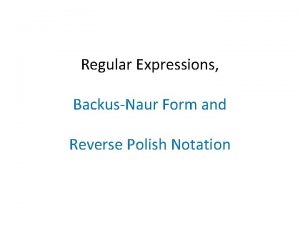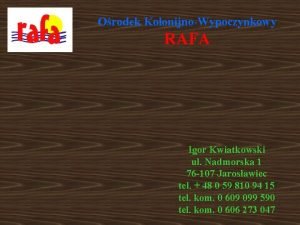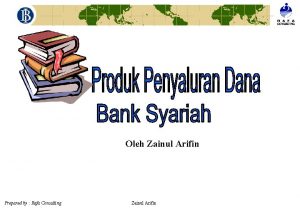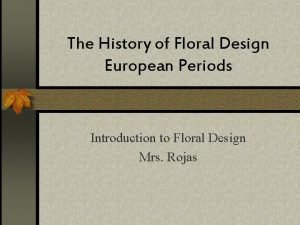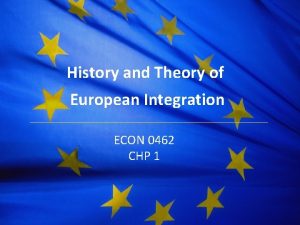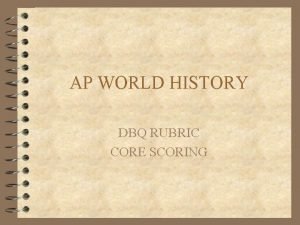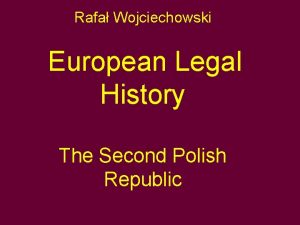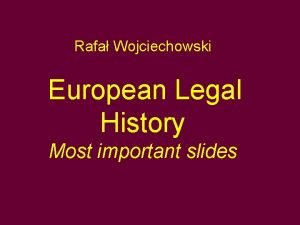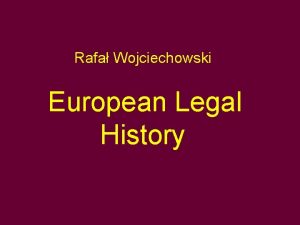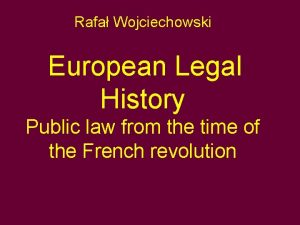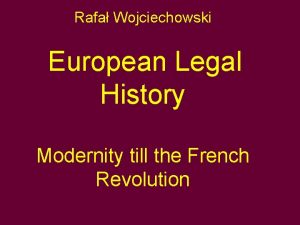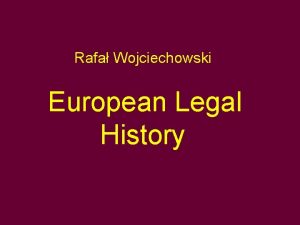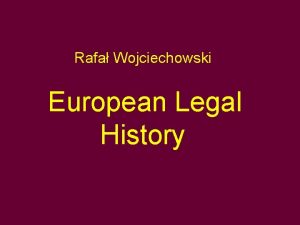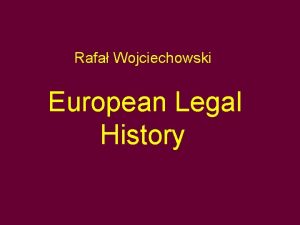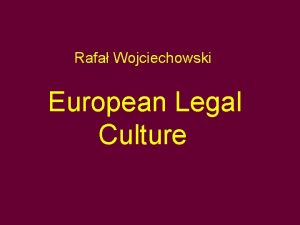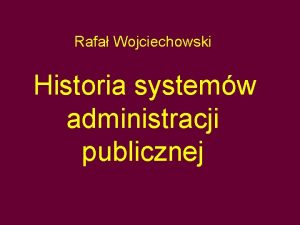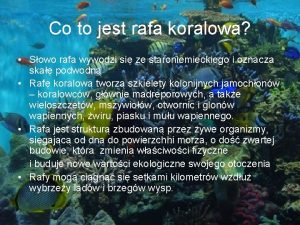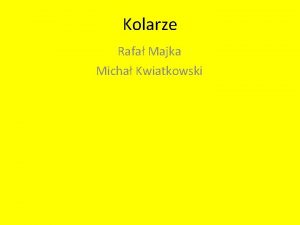Rafa Wojciechowski European Legal History The Second Polish














- Slides: 14

Rafał Wojciechowski European Legal History The Second Polish Republic

Origins of the Second Polish Republic Several centres of power emerged in Polish territories following the end of World War I. In the so called Kingdom of Poland the Regent Council was in place. It was appointed in 12. 09. 1917. It was composed of 3 members: primate bishop Aleksander Kakowski, Zdzisław Lubomirski and Józef Ostrowski. Initially it was intended to exercise power until a regent or king was appointed by the central states. It acted as a collective head of state and exercised legislative, executive and judicial functions. In December 1917, the Council appointed a government headed by Jan Kucharzewski. Makeshift legislative power was exercised by the 110 member Council of State, appointed in February 1918.

Origins of the Second Polish Republic 2 Meanwhile, in Paris in the summer of 1917, Roman Dmowski formed the National Committee of Poland (KNP), which was officially recognized by the governments of France, the United Kingdom and Italy as representative of Poland. After the Habsburg monarchy collapsed, several centres of power were formed within Galicia. The earliest, in October 1918, summoned the Polish National Council of the Cieszyn Kingdom. Next, Kraków was home to the Polish Liquidation Committee, led by W. Witos. It announced itself as the "temporary local government" and assumed power in the Austrian partition.

Origins of the Second Polish Republic 3 In July 1918, Poznań was home of the Central Citizens’ Committee, which cooperated with the KNP. The Committee had an executive committee which was unveiled on 3 December as the Supreme People’s Council (NRL). Meanwhile, in the Kingdom of Poland, groups opposed to the Regent Council formed the People’s Temporary Government of the Republic of Poland during the night of 6 -7 November, which was headed by the socialist Ignacy Daszyński. When Józef Piłsudski from Magdeburg on 10. 11. 1918, the Regent Council entrusted him with command of the army. The Council disbanded on 14 November and transferred its full authority to Piłsudski. The majority of the remaining centres of power aligned themselves with him over the next few days.

The Second Republic 1 A decree of 22. 11. 1918 made the state a republic. Until the legislative parliament (Sejm) was convened, supreme power was placed in the Temporary Head of State, who was Józef Piłsudski. On 20. 02. 1919 the Sejm passed a resolution on the temporary rules for the functioning of the state, called the Little Constitution. Following that, there was: the March Constitution of 17. 03. 1921 the August Amendments of 2. 08. 1926 to the March Constitution the April Constitution of 23. 04. 1935

The Second Republic 2 Geographically, the administration of the Second Republic was split into central and territorial administration. The former was exercised by the President, the Council of Ministers and individual ministers. The latter was divided into central government administration and local self-government administration. Central government administration was composed of departments of general administration (consolidated) and specialist (non-consolidated). The state was divided into provinces (voivodeships), counties, municipalities and rural communes.

The Second Republic 3 The President was elected by an absolute majority of the National Assembly for a 7 -year term. In the event of the President’s death or incapacity, his successor was the Marshal of the Sejm. The President held certain powers: v Head of State – e. g. represented the State externally v Executive – designated and dismissed the Prime Minister; appointed all higher-level civil servants at the request of the government v Legislative – convened and closed parliamentary sessions, issued regulations and orders v Judicial – nominated judges and wielded power of clemency The President’s authority was expanded by the August amendments to the constitution.

The Second Republic 4 The Council of Ministers was composed of the Prime Minister and individual ministers. The Prime Minister was only the coordinator of the government’s work (first among equals), not its leader. The number and competencies of ministers were set out in every case by the Sejm. The Economic Committee was an advisory body to the Council of Ministers. On 12. 1930 the Presidium of the Council of Ministers was formed. Its aim was to provide legal and organizational service to the government. It was divided into offices: legal, economic, administrative and presidential.

The Second Republic 5 The territorial administration which later was adopted as a model for the entire country was established in the former Russian partition. The final unification of general administration was effected on 19. 01. 1928. The state was divided into 16 provinces. Warsaw constituted a seperate entity with the rights of a province. A governor (voivode) was at the head of a province. He was appointed by the President on request of the Council of Ministers, presented by the Minister of Internal Affairs. He was seconded by the vice governor. The provincial office was the organ designed to assist the governor in his duties, and was divided into divisions and departments.

The Second Republic 6 Two collegial bodies functioned under the provincial governor, representing civic participation: the provincial council and the provincial department. The first was composed of representatives delegated by organs of county government, and was an advisory body. The provincial department was composed of the governor, two members selected by the council and two civil servants. It possessed advisory and categorical powers. Exceptions were the Pomerania and Poznań provinces, where provincial assemblies operated with the provincial department under the direction of the starosta.

The Second Republic 7 In Silesia and Warsaw the authorities were organized in an entirely different manner. Autonomy was introduced in Upper Silesia in 1920, on the basis of the founding statute of the Silesian province. As a result, the province possessed its own legislature – the Silesian Parliament, composed of 48 MPs, and its own executive – the Provincial Council, composed of the governor and 5 members selected by the Sejm. A separate Silesian Treasury was also established. Warsaw functioned as a province, and was divided into counties with county commissioners. The governmental commissar and city hall of Warsaw were organs of general administration.

The Second Republic 8 Commissioners directed county administration. They were appointed by the Minister of Internal Affairs, but were under the authority of provincial governors. From 1932, there were also urban commissioners, who were given authority over cities with at least 75, 000 residents. Gdynia was an exception, where a government commissar was installed. Organs of county self-government worked with the commissioner: county assemblies and county departments.

The Second Republic 9 After the Scaling Act of 23. 03. 1933, commune selfgovernment encompassed both individual and collective communes made of communities remaining in the old Kingdom of Poland. In the latter category, the community government still operated. Their legislative body was the council or assembly, and the bailiff served as the executive. In the rural communes, the rural council was the legislative body, formed by open and indirect elections, and the commune commission served as the executive body, formed by the prefect and eldermen selected by the council. Municipalities had city councils as their legislative bodies, selected in universal elections. Executive power was wielded by a governing council composed of the mayor and aldermen, selected by the city council.

The Second Republic 10 The Supreme Administrative Tribunal was formed by statute on 3. 08. 1922. Its founder was Jan Sawicki, a supporter of the Austrian administrative court system. The court was thus modeled on the Administrative Tribunal in Vienna, existing since 1875. Its territorial jurisdiction was restricted to lands of the Austrian and Russian partitions. The one-tier model supported by Jan Sawicki, rather than the multi-tiered model of Prussia and France, was applied. Administrative court proceedings in the Prussian partition remained multi-tiered.
 Polish notation and reverse polish notation
Polish notation and reverse polish notation What is prefix notation
What is prefix notation Serwer pocztowy pwr
Serwer pocztowy pwr The talent show by susan wojciechowski
The talent show by susan wojciechowski The talent show by susan wojciechowski
The talent show by susan wojciechowski Jarosławiec rafa
Jarosławiec rafa Rafa consulting
Rafa consulting European parliament legal affairs committee
European parliament legal affairs committee 186 282 miles per second into meters per second
186 282 miles per second into meters per second Middle ages floral design
Middle ages floral design European union history
European union history Roman era floral design
Roman era floral design Art of emerging europe
Art of emerging europe Ap world history frq rubric
Ap world history frq rubric History of floral design crossword
History of floral design crossword
